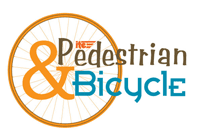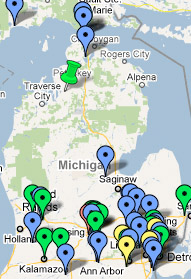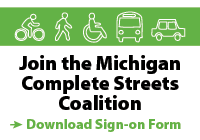
Click graphic to learn more about the Institute of Transportation Engineers Pedestrian & Bicycle Council
At the 2009 ITE Annual Meeting in San Antonio, the last panel of the last day focused on pedestrian safety, with a presentation by Meghan Mitman on recent crosswalk research and another by me on potential changes to the vehicle code, driver’s manual and Manual on Uniform Traffic Control Devices (MUTCD) to improve driver and pedestrian comprehension of crosswalk right of way.
Research performed by Meghan with David Ragland and Charlie Zegeer in the early part of the 2000s revealed a very troubling phenomenon related to a basic understanding of who has the legal right of way at uncontrolled crosswalks. Their research focused on California, where the California Vehicle Code requires that drivers yield to pedestrians at crosswalks and defines crosswalks as an extension of a sidewalk across an intersection, regardless of whether it is marked. Their research shows that the more complex the intersection, the less comprehension there is among drivers and pedestrians about who has the legal right of way: At intersections where all legs are marked, comprehension was greatest; and at intersections where no crosswalks are marked, comprehension is the worst with nearly half of drivers not understanding that they are legally required to yield the right of way to pedestrians.
The cardinal rule in transportation safety is to create conditions that are clear and predictable. That is, all roadway users know what is expected of them and how other roadway users are likely to behave. It is incredible and extremely troubling that pedestrian travel across such a prevalent type of facility as an unmarked crosswalk can cause such confusion. This is magnified by the fact that pedestrians are the most vulnerable roadway users, both because they are exposed (not protected by a large body of metal), and because they are disproportionately likely to be younger, older and disabled when compared to the average road user.
At the meeting, I presented a three-part strategy for addressing this significant inadequacy: changes to the uniform vehicle code, driver’s handbook and MUTCD. Some of the strategies are controversial and so will take considerable discussion among transportation professionals before they can be implemented-hence, this chair’s message and my sincere hope that you will weigh-in if you agree or disagree with my suggestions, below:
- Vehicle Code: In many situations, such as T-intersections on large, divided roadways, it is unreasonable to expect that drivers should correctly identify and interpret unmarked, uncontrolled crosswalks. The Minimum Model Vehicle Code should be modified such that pedestrians have the right of way only in marked crosswalks. I would recommend that any collision involving a pedestrian that takes place in a crosswalk become automatically the fault of the driver (currently, both drivers and pedestrians can be found to be at fault). Personally, I would like to extend this portion of the vehicle code, as some northern European countries have done, to say that any pedestrian-involved collision occurring within or just outside of a marked crosswalk is the driver’s fault. This should serve to strengthen the driver’s sense of responsibility while operating a machine that is capable of killing people.
- Driver’s Manual: Should the change to the vehicle code be implemented, a large public outreach effort would need to simultaneously occur. In addition, the driver’s handbook and training courses would need to be updated.
- MUTCD: Since the change proposed for the vehicle code represents a reduction of pedestrian mobility, I recommend that the MUTCD be changed to improve pedestrian safety at legal crossings. Traffic engineers rely on warrants to create uniformity and predictability in circumstances in which various traffic control devices are installed. While recent research has consistently detected the need for the installation of enhanced infrastructure, such as high-visibility markings, medians and beacons, crosswalks are routinely marked with just two 12-inch white lines, even on multilane and other roads where this is clearly an insufficient installation. Moreover, existing crosswalks with inadequate infrastructure exist throughout the United States. In addition to allowing new crosswalk control types, such as the HAWK beacon included in the 2009 edition of the MUTCD, future updates to the MUTCD should include guidelines for the use of these devices and should explicitly preclude basic crosswalk markings at locations where additional infrastructure is recommended in accordance with the research. However, the requirement for enhanced installations should not be permitted as an excuse to fail to accommodate pedestrians but rather should serve as a requirement to provide for safe and accessible pedestrian facilities at all significant desire lines. Specifically, where more than 30 pedestrians are observed crossing in any typical one hour period, a marked crosswalk should be installed.
That’s how I see it. How do you see it?
Matthew Ridgway
Chair ITE Pedestrian and Bicycle Council
Principal - Fehr & Peers
415-348-0300
[email protected]
















Leave a comment
Comments feed for this article